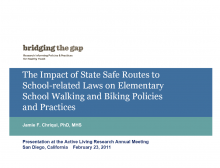We are pleased to announce an exciting new alliance between Active Living Research and GP RED to co-host and coordinate...
The Impact of State Safe Routes to School-Related Laws on Elementary School Walking and Biking Policies and Practices

Presentation at the 2011 Active Living Research Annual Conference
View project video on YouTube.
The Impact of State Safe Routes to School-related Laws on Active Travel to School Policies and Practices in U.S. Elementary Schools
JF Chriqui, DR Taber, SJ Slater, L Turner, KM Lowrey, & FJ Chaloupka
DOWNLOAD: Full article
Background:
Policies and practices that facilitate walking/biking to school are increasingly being considered by policymakers nationwide as a way to increase physical activity levels among school-age children. Safe Routes to School (SRTS) funding and programming also have focused the spotlight on walking/biking to school. Outside of SRTS, a number of states already have had laws on the books addressing sidewalk infrastructure surrounding schools and safety-related laws (e.g., requirements for crossing guards and speed zones around schools) not tied to a SRTS program. Yet, we know little about whether these laws may reduce the barriers to and/or facilitate walking/biking to school.
Objectives:
The purpose of this study was to examine the impact of state laws related to sidewalks and safe routes to school on elementary school-level policies and practices related to walking/biking to school. Specifically, we examined whether elementary school policies and practices differed in states with these laws as compared to schools located in states without these laws in terms of: (1) school-reported barriers to walking/biking to school; (2) allowing walking/biking to school; and (3) the proportion of students walking/biking to school.
Methods:
A quantitative analysis of the relationship between state laws and school-level policies and practices was conducted for the years 2007-2009. Codified statutory and/or administrative (regulatory) laws effective as of January 1 of each year for the 50 states and D.C. were identified and analyzed by staff at The MayaTech Corporation for the Bridging the Gap (BTG) Program. Four categories of laws were evaluated: requirements for sidewalks around schools and three safe routes to school-related laws - requirements for crossing guards, safety zones, and/or speed zones around schools. School-level data were obtained from a mail-back survey of principals in a nationally representative sample of US public elementary schools for each year as part of BTG’s Food & Fitness study. Responses were received from 578 schools (54.6%) in 2007, 748 schools (70.6%) in 2008, and 641 schools (62.2%) in 2009. The final survey data were adjusted to account for non-response bias and were weighted to reflect the percentage of schools nationwide. The surveys included questions related to barriers to walking/biking to school, whether students were allowed to walk/bike to school (all grades/some grades/no grades), and the percentage of students walking/biking to school. The barrier question asked principals to indicate their perceptions as to whether certain factors “may prevent 3rd grade students from walking/biking to school” including: school is too far away, traffic danger, lack of sidewalks, and no crossing guards.
Unadjusted and adjusted logistic regression analyses examined the variability in reported barriers and allowing walking/biking by whether the state law included the selected requirements (e.g., requirements for crossing guards or speed zones). Zero-inflated poisson regression models examined the relationship between the state laws and the percentage of students who walk/bike to school. The adjusted logistic regression and poisson regression models controlled for school size, locale, region, state law regarding minimum bussing distance requirements, and county funding for SRTS programs. The data on school size, locale and region were obtained from the National Center for Education Statistics’ Common Core of Data; the state laws regarding minimum bussing distance were compiled by the study team through primary legal research; and the county funding data were obtained from researchers at the Harvard Prevention Research Center through data obtained from the FHWA.
Results:
Schools were less likely to report lack of sidewalks or lack of crossing guards as barriers to walking/biking to school if the state law required sidewalks or guards, respectively, and were less likely to report traffic danger as a barrier if the state law required traffic control measures. Once adjusting for the control variables, schools were significantly less likely to report lack of crossing guards as a barrier if state law required them (OR=0.35, 95% CI= 0.22, 0.58) or to report traffic danger as a barrier if the state law required traffic control measures (OR=0.72, 95% CI=0.54, 0.98). Schools also were more likely to report that they allow biking to school in states that require crossing guards (OR=2.25, 95% CI = 1.43, 3.53). State laws were not associated with whether schools allowed walking to school. Schools were less likely to report zero students walking/biking to school if the state law required crossing guards (OR = 0.39, 95% CI= 0.20, 0.74) or traffic control measures (OR = 0.57, 95% CI= 0.38, 0.84). The state laws did not differentially affect the proportion of students that walk/bike to school in schools that reported any students walking/biking to school.
Conclusions:
State laws affecting sidewalks and safe routes to school are associated with school-level policies and practices related to walking/biking to school. Such laws should be considered in addition to formal SRTS funding/programming as a vehicle for facilitating walking/biking to elementary school.
Support:
This study was funded by the Robert Wood Johnson Foundation.
STAY UP TO DATE
RECENTLY ADDED TOOLS & RESOURCES
MOVE! A BLOG ABOUT ACTIVE LIVING
The "Active Living Conference" aims to break down research and practice silos and...







